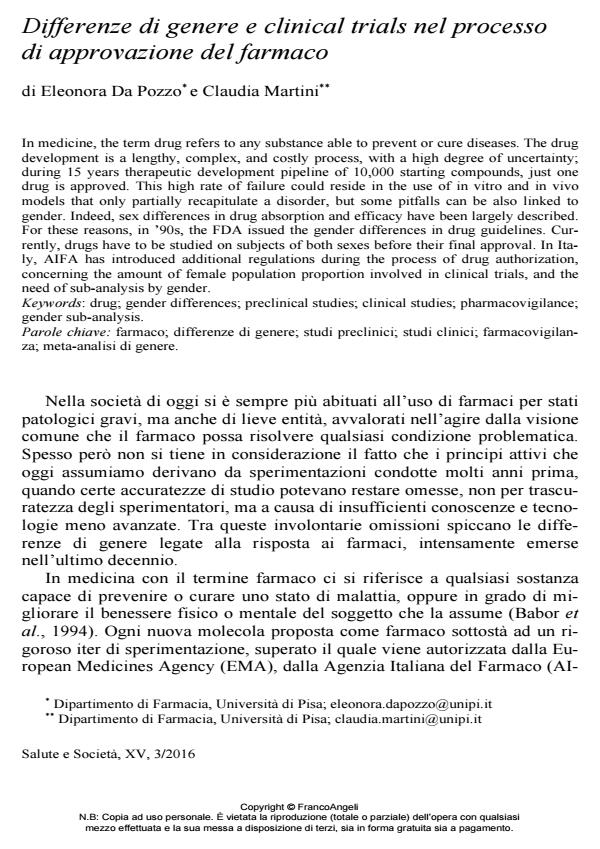Differenze di genere e clinical trials nel processo di approvazione del farmaco
Journal title SALUTE E SOCIETÀ
Author/s Eleonora Da Pozzo, Claudia Martini
Publishing Year 2016 Issue 2016/3
Language Italian Pages 9 P. 134-142 File size 47 KB
DOI 10.3280/SES2016-003011
DOI is like a bar code for intellectual property: to have more infomation
click here
Below, you can see the article first page
If you want to buy this article in PDF format, you can do it, following the instructions to buy download credits

FrancoAngeli is member of Publishers International Linking Association, Inc (PILA), a not-for-profit association which run the CrossRef service enabling links to and from online scholarly content.
In medicine, the term drug refers to any substance able to prevent or cure diseases. The drug development is a lengthy, complex, and costly process, with a high degree of uncertainty; during 15 years therapeutic development pipeline of 10,000 starting compounds, just one drug is approved. This high rate of failure could reside in the use of in vitro and in vivo models that only partially recapitulate a disorder, but some pitfalls can be also linked to gender. Indeed, sex differences in drug absorption and efficacy have been largely described. For these reasons, in ’90s, the FDA issued the gender differences in drug guidelines. Currently, drugs have to be studied on subjects of both sexes before their final approval. In Italy, AIFA has introduced additional regulations during the process of drug authorization, concerning the amount of female population proportion involved in clinical trials, and the need of sub-analysis by gender.
Keywords: Drug; gender differences; preclinical studies; clinical studies; pharmacovigilance; gender sub-analysis.
- Agenzia Italiana del Farmaco. Come nasce un farmaco. Informazioni disponibili al sito: http://www.agenziafarmaco.gov.it/it/content/come-nasce-un-farmaco. Data di consultazione: Aprile 2016.
- Babor T., Campbell R., Room R., Saunders S., a cura di (1994). Lexicon of alcohol and drug terms. Geneva: World Health Organization.
- Becker D.M., Segal J., Vaidya D., Yanek L.R., Herrera-Galeano J.E., Bray P.F., Moy T.F., Becker L.C., Faraday N. (2006). Sex differences in platelet reactivity and response to low-dose aspirin therapy. Journal of the American Medical Association, 295: 1420-7. DOI: 10.1001/jama.295.12.142
- Buchanan F.F., Myles P.S., Cicuttini F. (2011). Effect of patient sex on general anaesthesia and recovery. British Journal of Anaesthesia, 106: 832-9. DOI: 10.1093/bja/aer09
- Caspard H., Chan A.K., Walker A.M. (2005). Compliance with a statin treatment in a usual-care setting: retrospective database analysis over 3 years after treatment initiation in health maintenance organization enrollees with dyslipidemia. Clinical Therapeutics, 127: 1639-46. DOI: 10.1016/j.clinthera.2005.10.005
- Franconi F., Brunelleschi S., Steardo L., Cuomo V. (2007). Gender differences in drug responses. Pharmacological Research, 55: 81–95. DOI: 10.1016/j.phrs.2006.11.00
- Franconi F., Campesi I. (2013). Introduzione alla Farmacologia di Genere. Giornale Italiano di Farmacoeconomia e Farmacoutilizzazione, 5: 11-17.
- Franconi F., Campesi I., Sassu A. (2010). Per una farmacologia di genere. Monitor – Trimestrale dell’Agenzia nazionale per i servizi sanitari regionali, 26: 21-28.
- Frezza M., di Padova C., Pozzato G., Terpin M., Baraona E., Lieber C.S. (1990). High blood alcohol levels in women. The role of decreased gastric alcohol dehydrogenase activity and first-pass metabolism. New England Journal of Medicine, 322: 95-9. DOI: 10.1056/NEJM19900111322020
- Gan T.J., Glass P.S., Sigl J., Sebel P., Payne F., Rosow C., Embree P. (1999). Women emerge from general anesthesia with propofol/alfentanil/nitrous oxide faster than men. Anesthesiology, 90: 1283-7. DOI: 10.1097/00000542-199905000-0001
- Glaser R., Sheridan J., Malarkey W.B., MacCallum R.C., Kiecolt-Glaser J.K. (2000). Chronic stress modulates the immune response to a pneumococcal pneumonia vaccine. Psychosomatic Medicine, 62(6): 804-7. DOI: 10.1097/00006842-200011000-0001
- Hansson L., Zanchetti A., Carruthers S.G., Dahlöf B., Elmfeldt D., Julius S., Ménard J., Rahn K.H., Wedel H., Westerling S. (1998). Effects of intensive bloodpressure lowering and low-dose aspirin in patients with hypertension: principal results of the Hypertension Optimal Treatment (HOT) randomised trial. HOT Study Group. Lancet, 351: 1755-62. DOI: 10.1016/S0140-6736(98)04311-
- Kessel M., Frank F. (2007). A better prescription for drug-development financing. Nature Biotechnology, 25: 859-866. DOI: 10.1038/nbt0807-85
- Klein S.L., Marriott I., Fish E.N. (2015). Sex-based differences in immune function and responses to vaccination. Transactions of the Royal Society of Tropical Medicine and Hygiene, 109: 9-15. DOI: 10.1093/trstmh/tru16
- Kornstein S.G., Schatzberg A.F., Thase M.E., Yonkers K.A., McCullough J.P., Keitner G.I., Gelenberg A.J., Davis S.M., Harrison W.M., Keller M.B. (2000). Gender differences in treatment response to sertraline versus imipramine in chronic depression. American Journal of Psychiatry, 157: 1445–52. DOI: 10.1176/appi.ajp.157.9.144
- Luzier A.B., Killian A., Wilton J.H., Wilson M.F., Forrest A., Kazierad D.J.
- (1999). Gender-related effects of metoprolol pharmacokinetics and pharmacodynamics in healthy volunteers. Clinical Pharmacology and Therapeutics, 66: 594–601. DOI: 10.1053/cp.1999.v66.10340000
- Posey Norris S.M., Pankevich D.E., Davis M., Altevogt B.M., a cura di (2014). Improving and Accelerating Therapeutic Development for Nervous System Disorders: Workshop Summary. Washington D.C.: the national academies press.
- Rescigno A., Thakur A.K., a cura di (1990). New Trends in Pharmacokinetics.
- New York: Plenum Press. Ridker P.M., Cook N.R., Lee I.M., Gordon D., Gaziano J.M., Manson J.E., Hennekens C.H., Buring J.E. (2005). A randomized trial of low-dose aspirin in the primary prevention of cardiovascular disease in women. The New England Journal of Medicine, 352: 1293-1304. DOI: 10.1056/NEJMoa05061
- Soldin O.P., Mattison D.R. (2009). Sex differences in pharmacokinetics and pharmacodynamics. Clinical Pharmacokinetics, 48(3): 143-57. DOI: 10.2165/00003088-200948030-0000
- Tran C., Knowles S.R., Liu B.A., Shear N.H. (1998). Gender differences in adverse drug reactions. Journal of Clinical Pharmacology, 38: 1003–9. DOI: 10.1177/00912700980380110
- Ministero della Salute, a cura di (2016). Il genere come determinante di salute. Lo sviluppo della medicina di genere per garantire equità e appropriatezza della cura. Quaderni del Ministero della Salute n. 26. Testo disponibile al sito: http://www.quadernidellasalute.it/quaderni-html/26-aprile-2016.php. Data di consultazione: Aprile 2016.
Eleonora Da Pozzo, Claudia Martini, Differenze di genere e clinical trials nel processo di approvazione del farmaco in "SALUTE E SOCIETÀ" 3/2016, pp 134-142, DOI: 10.3280/SES2016-003011